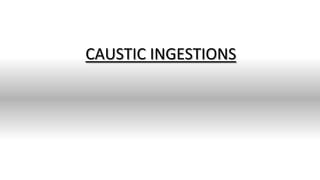
CAUSTIC INGESTIONS.pptx
- 2. Caustics are substances that cause both functional and histologic damage on contact with body surfaces
- 3. Caustics are broadly classified as alkalis (pH >7) or acids (pH <7)
- 4. Alkaline ingestions predominate in the developed world whereas acid ingestions are more common in developing countries
- 5. •Caustic exposures tend to fall into three distinct groups: (1)intentional adolescent or adult ingestions with suicidal ideation; (2)unintentional ingestions (the majority of which are by curious children inthe toddler age group); and (3)other incidental, often occupational or industrial contact exposures
- 7. PATHOPHYSIOLOGY • Tissue injury is determined by a number of factors: pH, concentration, duration of contact,volume, and titratable acid or alkaline reserve. • Acids tend to cause significant injuries at a pH <3 and alkalis at a pH >11. • Following ingestion, solid or granular caustics often injure the oropharynx and proximal esophagus, whereas liquid alkali ingestions are characterized by more extensive esophageal and gastric injuries. • Titratable acid or alkaline reserve refers to the amount of acid or base required to neutralize the agent; the greater this value, the greater is the potential for tissue injury.
- 8. PATHOPHYSIOLOGY • Esophageal mucosal burns from caustic ingestions are classified by a visual endoscopic grading system, which correlates with risk of futurecomplications: • Grade 1 burns involve tissue edema and hyperemia; • Grade 2 burns include ulcerations, blisters, and whitish exudates, which are subdivided into grade 2A (noncircumferential) and 2B (deeper or circumferential) lesions • Grade 3 burns are defined by deep ulcerations and necrotic lesions
- 9. PATHOPHYSIOLOGY • Following the initial mucosal injury, tissue remodeling occurs over roughly 2 months. • In mild cases, normal esophageal function is restored, but in severe cases, dense scar tissue forms, resulting in stricture formation • Early phases of remodeling, particularly days 2 to 14 after exposure, are associated with increased tissue friability and higher risk of perforation, both spontaneous and iatrogenic
- 10. PATHOPHYSIOLOGY • Solids/pills are prone to lodging at anatomy narrowings - Upper and lower esophageal sphincters - Tracheal bifurcations - Oesophageal webs and strictures • Stomach contents – protective (GOOD ) • Pylorspasm – prolongs contact time in stomach (BAD)
- 11. PATHOPHYSIOLOGY ALKALIS – LIQUEFACTION NECROSIS ACID – COAGULATION NECROSIS Dehydrates superficial tissues to form tough leathery eschar Systemically absorbed , may cause hemolysis and acidosis
- 12. ALKALI INJURIES • hydroxide ion easily penetrate tissues → immediate cellular destruction via protein denaturation and lipid saponification. • followed by thrombosis of local microvasculature that leads to further tissue necrosis. • Causes deep tissue injury called liquefaction necrosis • Severe intentional alkali ingestion may cause deep penetration into surrounding tissues with resultant multisystem organ injuries, including esophageal injury,gastric perforation, and necrosis of abdominal and mediastinal structures. Severe injuries to the pancreas, gallbladder, small intestine, and mediastinum
- 13. ALKALI INJURIES • The most common household alkali is bleach, a 3% to 6% sodium hypochlorite solution with a pH of approximately 11 • Household liquid bleach is minimally corrosive to the esophagus and rarely causes significant injury beyond grade 1 esophageal burns. • However, ingestion of industrial-strength bleach containing much higher concentrations of sodium hypochlorite may result in gastric and esophageal necrosis. • Bleach ingestion may cause emesis secondary to gastric irritation and/or pneumonitis after aspiration. • Pulmonary irritation related to chlorine gas production in the stomach or when mixed with other substances may also occur.
- 14. ACID • Injuries by strong acids produce coagulation necrosis. • Dissociated hydrogen ions and their associated anions penetrate tissues, leading tocell death and eschar formation. This process is believed to limit continued hydrogen ion penetration and protect against deeper injury. • When ingested acids settle in the stomach, gastric necrosis, perforation, and hemorrhage may result
- 17. • Assess for hemodynamic instability. • Causes of shock include GI bleeding, complications of GI perforation, volume depletion, and toxicity from co-ingestants. • Examine for peritoneal signs due to hollow viscous perforation. Consider mediastinitis in patients complaining of chest discomfort, and palpate the chest wall and neck for signs of subcutaneous emphysema. • Inspect the eyes for ocular burns and the skin for splash and dribble burns
- 18. LABS • For an intentional ingestion or ingestion of a strong acid or alkali, laboratory evaluation should include : - venous or arterial blood gas, electrolyte panel, hepatic profile, complete blood count, lactate, and blood type and screen • Caustic ingestions can cause an anion gap acidosis based on lactate production due to direct tissue injury or shock. • Strong acid ingestions may be associated with both severe anion gap (e.g., sulfuric acid) and nongap acidoses (e.g., hydrochloric acid) • In suicidal patients, obtain acetaminophen and salicylate levels to screen for potential coingestants. • An ECG is indicated following a hydrofluoric acid exposure to check for QT interval prolongation from hypocalcemia
- 22. TREATMENT
- 23. TREATMENT
- 24. TREATMENT
- 25. TREATMENT